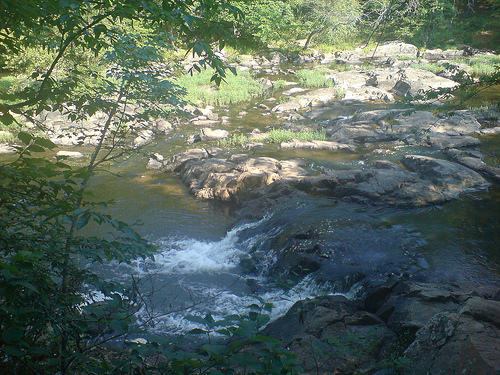Eno Indians
 The Eno Indians were likely one of the loosely related tribes of Siouan-speaking Native Americans living in the Piedmont of what is now North Carolina at the time of European exploration. Little is known about them, and their existence is recorded primarily in seventeenth- and early eighteenth-century Virginia and North Carolina documents. Although their villages of Eno Town and Adshusheer in what is now Durham County have not been located, some information about related Siouan-speaking peoples in the region has been found through the long-term Siouan Project of the Research Laboratories of Archaeology at the University of North Carolina at Chapel Hill.
The Eno Indians were likely one of the loosely related tribes of Siouan-speaking Native Americans living in the Piedmont of what is now North Carolina at the time of European exploration. Little is known about them, and their existence is recorded primarily in seventeenth- and early eighteenth-century Virginia and North Carolina documents. Although their villages of Eno Town and Adshusheer in what is now Durham County have not been located, some information about related Siouan-speaking peoples in the region has been found through the long-term Siouan Project of the Research Laboratories of Archaeology at the University of North Carolina at Chapel Hill.
Governor George Yeardley of Virginia first mentioned the Eno Indians (whom he called Haynokes) in connection with their resistance to Spanish explorers. In 1670 John Lederer, a German explorer, gave a somewhat detailed description of the tribe he called the Oenock Indians, who commonly hired themselves out as porters and carriers to neighboring tribes. A few years later, traders' accounts located Aeno- or Eno-Town as a two-days' journey from the Occaneechi village (then located on the Roanoke River) and close to the Great Trading Path that ran roughly from present-day Petersburg, Va., to the Catawba Indian communities in South Carolina.
John Lawson, surveyor general of the colony of Carolina, tells of meeting with Eno-Will, a leader of the Eno Indians and related tribes, in his 1701 exploration. He was entertained at Occaneechi, then located on the Eno River near Hillsborough, and Adshusheer, a combined Eno, Shakori, and Adshusheer village 14 miles east of Occaneechi. Lawson's is the only extended description of the culture of these related tribes.
The combined tribes at Adshusheer suggest the decline in numbers that the individual tribes had already suffered. In 1716 Governor Alexander Spotswood of Virginia tried to settle their remnant permanently at Eno-Town to act as protection from more hostile tribes, but the governors of North Carolina and South Carolina opposed the plan. From this time on, the Eno tribe disappears from the historical record. They were possibly incorporated into the Catawba Nation. William Byrd's history of the survey of the dividing line between Virginia and North Carolina in 1729 presents an elderly, demoralized Shacco-Will, who is almost unrecognizable as Lawson's earlier dignified, respected, and responsible Eno-Will.
References:
Douglas L. Rights, The American Indian in North Carolina (1957).
H. Trawick Ward and R. P. Stephen Davis Jr., Indian Communities on the North Carolina Piedmont, A.D. 1000 to 1700 (1993).
Additional Resources:
The First Mention of the Eno Indians, Eno River: http://www.enoriver.org/store/journals/nativeamericanissue/1654-2/
Image Credit:
"Eno River State Park, NC." Eno State Park was the home of the Eno Indians. Photo courtesy of Flikr user airborneshodan, uploaded on June 7, 2008. Available from https://www.flickr.com/photos/airborneshodan/4739851688/ (accessed May 23, 2012).
1 January 2006 | Anderson, Jean B.